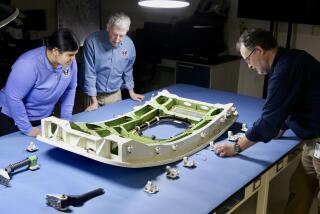Importance of Shuttle Wing Shield’s Age Is Questioned
- Share via
WASHINGTON — Analysis of a crucial test in the Columbia accident investigation suggests that the age of a damaged wing shield may not have played a central role in the space shuttle’s breakup, a leading investigator said Friday.
Columbia, first launched in 1981, was NASA’s oldest shuttle. The wing shield that investigators believe failed during reentry Feb. 1 had flown on all 28 Columbia missions before the disaster, investigators said.
But test results indicate that a foam strike on the wing during Columbia’s liftoff could have been forceful enough to have broken even a new shield, said Scott Hubbard, a member of the Columbia Accident Investigation Board.
In a test conducted Monday, a 1.68-pound block of foam was fired at curved panels of a material known as reinforced carbon carbon or RCC. Those panels shield the leading edge of the shuttle’s wing from the searing heat of reentry.
Analysis of test results showed that the impact caused stresses on the RCC wing panel that exceeded its maximum design strength by 50% or more, Hubbard said. It left a gaping hole in the panel.
The data led Hubbard to voice an opinion that would appear at odds with the frequent argument that Columbia was simply too old to fly.
“This impact would have broken even brand-new RCC ... even if it was fresh off the factory floor,” said Hubbard.
Board spokeswoman Laura Brown said the role of the shuttle’s age in the catastrophe may never be precisely known. “We do know that aging affects RCC panels -- they lose some of their mass,” she said.
“We don’t know in fact what the strength of that panel [on Columbia] was,” she added. “Even if it was a new panel, the amount of force [from the foam strike] would have broken it.”
Investigators have also found that the strength of individual panels can vary widely, she said.
Hubbard spoke at a news conference here as the investigation board plunged into writing a final report on the nation’s second space shuttle disaster in 17 years. The report is expected by the end of August.
Monday’s test was considered critical, since it validated the leading theory that a foam debris strike 82 seconds into launch blew a gash in the wing. Investigators think that superheated gases surged through the hole during reentry, causing structural damage that led to the shuttle’s breakup over Texas.
In a lengthy chronology released Friday, investigators estimated the size of the actual hole at six to 10 inches in diameter.
Harold W. Gehman Jr., the retired Navy admiral who heads the board, said he expects the probe to cost from $15 million to $20 million. That total does not include far greater sums spent on NASA’s own internal review and on a huge multi-agency effort to recover Columbia debris.
The Senate on Friday approved legislation that would double, to $100 million, federal spending on the accident response and investigation. House action is expected shortly.
The key findings of the board’s report are by now widely known, the result of frequent news briefings. Investigators have also released interim recommendations to help NASA return its three remaining shuttles to flight by next year. The most difficult immediate tasks the board has given NASA are to minimize foam shedding in future liftoffs and to design a way to repair exterior damage to a shuttle during flight.
Gehman said Friday that the board is wrestling with issues involving NASA’s management and safety oversight -- subjects of past reports by other commissions and experts.
“One of our findings is going to be, ‘NASA, you’re not listening,’ ” Gehman said.
NASA’s administrator, Sean O’Keefe, who took office about a year before the disaster, has pledged to respond to the board’s recommendations. Also Friday, Hubbard said Monday’s test produced more than a gaping hole in the mock wing shield. There was also “a whole maze of cracks,” some up to 11 inches long, he said.
Hubbard said the cracks suggested dangling pieces of RCC may have been among the first parts of the shuttle to break off.
Hubbard also said that a piece of torn RCC may have been the mysterious object that radar images captured floating away from the orbiter on its second day of flight.
And, he said, the test showed that another part of the wing’s leading edge, known as the T-seal, may have been damaged by the foam strike at liftoff, causing the T-seal to flap and scrape portions of the wing. Hubbard said that theory would explain puzzling markings found on certain recovered debris.
“We are able now to explain a lot of pieces of data that before we were only able to speculate about,” Hubbard said.
More to Read
Sign up for Essential California
The most important California stories and recommendations in your inbox every morning.
You may occasionally receive promotional content from the Los Angeles Times.













